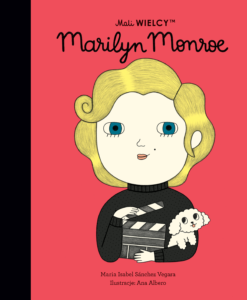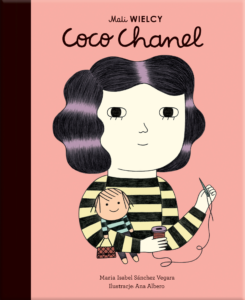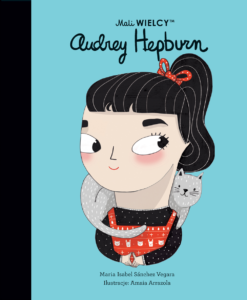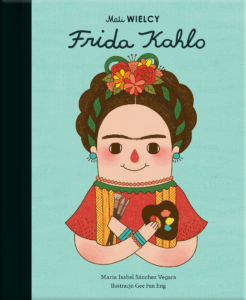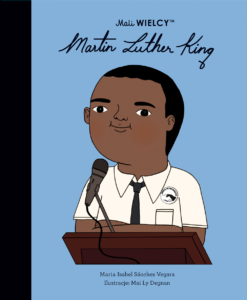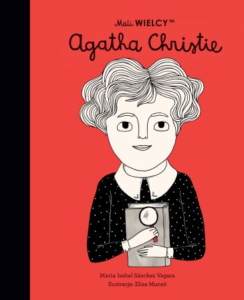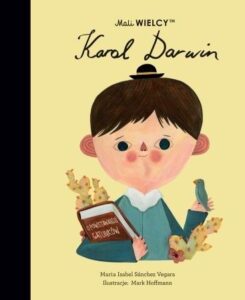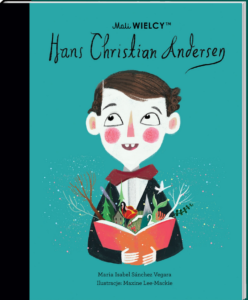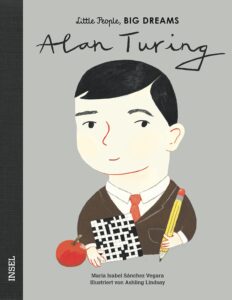Wywiad z María Isabel Sánchez Vegara / Interview with María Isabel Sánchez Vegara
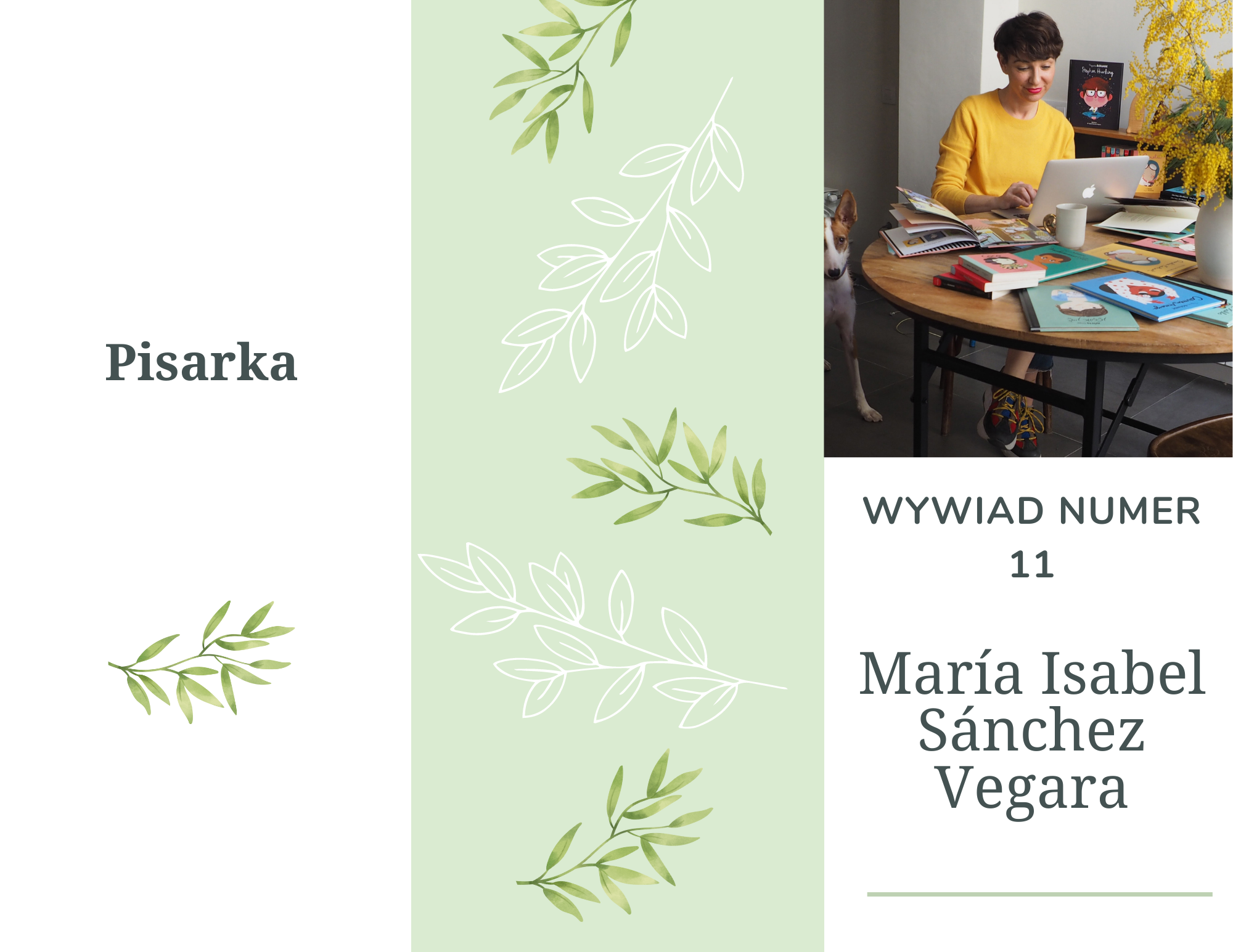
Zapraszam na wywiad z autorką serii Little People, BIG DREAMS (Mali Wielcy po polsku), Marią Isabel Sánchez Vegara!
Ja uwielbiam te książki i jestem przeszczęśliwa, że autorka zgodziła się odpowiedzieć na moje pytania 🙂
Może na początek opowiesz coś o sobie? Zawsze chciałaś zostać autorką książek dla dzieci?
¡Hola!
Nazywam się Maria Isabel Sánchez Vegara i jestem autorką i dyrektorem kreatywnym serii Mali Wielcy (eng. Little People, BIG DREAMS).
Lubię jogę, kaktusy i ogrodniczki. Żyję szczęśliwie w górach z Dirkiem, moim mężem oraz suczką o imieniu Lupe.
Kiedy miałam sześć lat, każdego wieczoru – zaraz po tym, jak moi rodzice wyłączyli światło w moim pokoju – czytałam latarką historie pod prześcieradłem. W zasadzie wszystko, co wpadło mi w ręce. Kiedy trochę podrosłam, stałam się wielkim fanem twórczości Michaela Ende i w kółko czytałam Momo i Niekończącą się historię. Ale kochałam też Mikołajka, Charliego i Fabrykę Czekolady, Matyldę…
Oczywiście marzyłam o pisaniu. Miałam mnóstwo zeszytów pełnych wierszy i dziwnych nastoletnich myśli. Przez lata chciałam być dziennikarką, ale jakoś skończyłam najpierw jako copywriter, a później jako dyrektor kreatywny w agencji reklamowej. Praca bardzo mi się podobała, ale koniec końców, to tylko praca. Więc kontynuowałam pisanie poezji i opowiadań dla siebie, aż udało mi się opublikować swoją pierwszą książkę.
Jak to wszystko się zaczęło? Skąd pomysł na serię Little People BIG DREAMS (Mali Wielcy po polsku)?
Narodziny moich bliźniaczych siostrzenic zainspirowały mnie do napisania serii w 2012 roku.
Poszłam więc poszukać dla nich książki i byłam pod wrażeniem, że wszystko wyglądało trochę jak wtedy, gdy byłam małą dziewczynką: nie było zbyt wielu fajnych historii o bohaterkach do wyboru.
Wtedy przyszły mi do głowy wszystkie prawdziwe bohaterki w historii. Zdałam sobie sprawę, że tych historii brakuje na dziecięcych półkach i zdecydowałam, że Alba i Claudia muszą o nich wiedzieć.
Opowiesz trochę o jej początkach? Jaki tytuł powstał jako pierwszy i dlaczego akurat taki?
Pierwszą książką z serii była ta poświęcona Coco Chanel.
Zafascynowało mnie to, jak przełożyła na modę wszystkie wielkie zmiany społeczne, jakie przeżywały kobiety w jej czasach.
Czy seria szybko zyskała popularność?
Właśnie opublikowaliśmy drugą książkę z serii w Hiszpanii – tę o Fridzie Kahlo – kiedy angielskie wydawnictwo Quarto zainteresowało się wydaniem serii. To był punkt zwrotny, który sprawił, że seria rozrosła się naprawdę szybko i stała się rozpoznawalna na całym świecie.
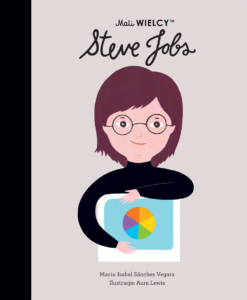
Ile obecnie tytułów liczy seria?
Właśnie piszę setny tytuł, który ukaże się w następnym roku. Będzie dedykowany ugandyjskiej aktywistce klimatycznej Vanessie Nakate, niesamowitej kobiecie, którą bardzo podziwiam.
Masz swoje ulubione tytuły? 😊
Szczerze mówiąc, za każdym razem, gdy zaczynam pisać o nowej postaci, na chwilę staje się ona moją ulubioną. Naprawdę wciągają mnie ich historie!
Ale gdybym miała wybrać jeden tytuł z serii, może Frida Kahlo należałaby do moich ulubionych.
Na jakiej podstawie wybierasz bohaterów książek?
Little People BIG DREAMS to hołd dla marzycieli, którzy realizowali marzenia, bez względu na to, jak niemożliwe wydawało się to niemożliwe.
Z tego miejsca wszystko jest dość intuicyjne: wybieram ludzi, których żałuję, że nie poznałam, kiedy byłam małą dziewczynką.
Nie szukam tylko kobiet lub mężczyzn, którzy po prostu osiągnęli szczyt w swojej karierze jako projektantki, malarki, piloci, pisarki, badacze lub śpiewacy. Poszukuję również pełnych pasji i wyjątkowych ludzi o wielkich osobowościach.
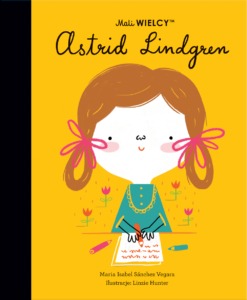
Trudno jest streścić czyjś życiorys na 32 stronach?
Staram się stosować bardzo podstawową zasadę: mniej znaczy więcej. Więc im prościej, tym lepiej.
Nie oczekuję, że dzieciaki zrozumieją, czym właściwie jest polon (w przypadku Marie Curie) lub jakie są największe tytuły Agathy Christie. Dla mnie o wiele ważniejsze jest zrozumienie, co ich poruszyło: jakie mieli marzenia jako dzieci, jakie były ich zainteresowania i jak pokonali wszystkie przeszkody na swojej drodze.
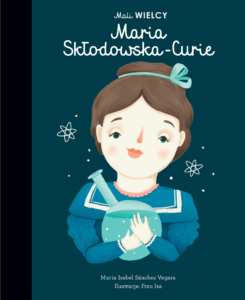
Często musisz ‘cenzurować’ historię lub coś pomijać?
Jedną z największych decyzji, jakie musiałam podjąć, kiedy zaczęłam planować serię, było zakończenie każdej z historii. Nie chciałam, żeby historie były smutne, ale żeby były celebracją wszystkich niesamowitych rzeczy, które możemy zrobić, jeśli spróbujemy.
Dlatego wszystkie historie kończą się na małym dziecku, które poznaliśmy na początku opowieści, patrząc wstecz na to, co osiągnęło. Co do każdej konkretnej historii, staram się wyjaśniać fakty w sposób pełen nadziei, skupiając się na pozytywnym i budzącym empatię dzieci do bohatera.
Są ‘nazwiska’, które są najpopularniejsze? Zaobserwowałaś, żeby jakieś tytuły cieszyły się większym powodzeniem?
Lubię myśleć, że dla każdego dziecka jest charakter, do którego może czuć się bardziej przywiązany. Ale oczywiście niektóre wielkie nazwiska są bardziej popularne niż inne, takie jak Marie Curie, Amelia Earhart, Malala Yousafzai, David Bowie czy Mahatma Gandhi.

Czy któryś tytuł budził kontrowersje? Były głosy, że akurat ta osoba nie zasługuje na bycie wzorem dla dzieci?
Czasami dostaję wiadomości od rodziców, którzy nie zgadzają się z konkretnym wyborem. Wraz z moimi redaktorami staramy się zwracać uwagę i uczyć się od krytyków. Jednak ostatecznie nigdy nie da się zadowolić wszystkich.
Czy popularność poszczególnych tytułów różni się w różnych krajach?
Ulubione tytuły zmieniają się nieco w zależności od miejsca, ale nadal są do siebie podobne. Żyjemy w globalnym świecie, w którym wszyscy dzielimy odniesienia kulturowe, gusta i postawy. Przesłanie serii jest na tyle uniwersalne, że mam nadzieję, że zainteresuje wszystkich tak samo.
W serii znajdziemy postacie historyczne i wciąż żyjące. Czy te, które żyją ( np. Michele Obama lub Malala) wiedzą, że powstanie o nich książka? Znajdą wcześniej treść?
Moi redaktorzy starają się nawiązać kontakt z większością z nich. Mam w domu piękny list od Davida Attenborough, w którym mówi mi, jak bardzo podobała mu się książka o nim, i wiem, że zarówno wnuki Ernesta Shackletona, jak i Corazona Aquino uwielbiały książki o swoich dziadkach.
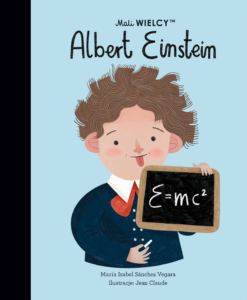
Są jakieś postacie, o których chciałaś napisać książkę, ale z jakiegoś powodu nie mogłaś?
Jak dotąd nie, więc… trzymajmy kciuki! 🙂
Napisałaś już wiele książek i dobrze poznałaś życiorysy wielu osób. Czy jest ktoś, z kimś czujesz szczególną wieź? Czy któraś historia zrobiła na Tobie wyjątkowe wrażenie?
Anne Frank i Alan Turing to dwie historie, które wciąż robią na mnie największe wrażenie. Były też najtrudniejsze do napisania.
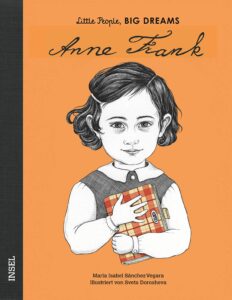
Opisałaś historie kogoś, kogo chciałabyś poznać osobiście?
Żałuję, że nie poznałam wszystkich ludzi z serii, ale jak dotąd miałam szczęście spotkać Jane Goodall, obrończynię dzikiej przyrody. Spotkałam ją w Madrycie kilka lat temu i podpisała kopię mojej książki, którą trzymam w domu.
Ważną częścią każdej książki są także ilustracje. Skąd pomysł na innego ilustratora do każdego tytułu?
Seria jest zarówno celebracją różnorodności, jak i wyjątkowości, i wiedziałam, że grafika musi pokazywać to całe bogactwo. Niektóre historie musiały być kolorowe i zabawne, a inne wręcz przeciwnie, ciemniejsza paleta kolorów lub bardziej realistyczny styl, więc nie było mowy, aby jeden ilustrator mógł być dla nich wszystkich idealnym artystą.
Na jakiej podstawie wybierasz ilustratora do danego tytułu? Czy mają oni ‘wolną rękę’ w pracy?
Czasami mój wybór opiera się na ich stylu i innych, szukam też jakiegoś związku między postacią a osobistą historią ilustratora. A raz na jakiś czas jest to mieszanka obu tych rzeczy.
Na przykład kiedy szukałam artysty, który ożywiłby historię Anne Frank, wiedziałam, że ilustracje muszą być bardziej realistyczne niż zwykle i czarno-białe, jak wszystkie obrazy z tamtego mrocznego okresu w historii. Poza tym pomyślałam też, że kluczowe jest oddanie głosu żydowskiej ilustratorce, więc poprosiłam niesamowitą Svetę Doroshevę, aby nad tym pracowała.
Moim celem jest, aby styl każdego ilustratora wyróżniał się, ale jednocześnie prowadzę ich przez cały proces, aby zapewnić spójność między sobą.
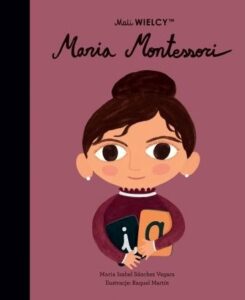
Planujesz przygotować także tytuły dla starszych dzieci?
Właściwie planuję wydać książkę nie dla starszych dzieci, ale dla niemowląt. Jest już napisana i miejmy nadzieję, że zostanie opublikowana po angielsku w przyszłym roku.
Czym nas jeszcze zaskoczy seria Little people BIG DREAMS? 😊
Tak, myślę, że będzie jedna lub dwie niespodzianki. Ale ponieważ są niespodzianką, wolę nie mówić o nich zbyt wiele. Będziecie musieli poczekać i zobaczyć… 🙂
Tłumaczenie: Katarzyna Sukiennik
Tutaj przeczytacie wywiad w wersji oryginalnej 🙂
Tell us something about yourself. Did you always want to be a children’s book author?
¡Hola!
My name is Maria Isabel Sánchez Vegara and I’m the author and creative director of the Little People, BIG DREAMS series.
I like yoga, cacti and dungarees and I live happily in the mountains with Dirk, my husband and a lady dog called Lupe.
When I was six, every night -right after my parents had turned off the lights in my room- I kept reading stories under the sheets with my flashlight. Basically anything that felt into my hands. When I got a bit older, I became a big fan of Michael Ende’s work and read Momo and The Never Ending Story over and over again. But I also loved Le Petit Nicolas, Charlie and the Chocolate Factory, Matilda,…
Of course, I dreamt of writing. I had lots of notebooks full of poems and weird teen thoughts.
For years I wanted to be a journalist but, somehow, I ended up working first as a copywriter and later as a creative director in an advertising agency.
A job I enjoyed very much, but at the end, only a job. So I continued writing poetry and short stories for myself until I managed to auto publish my first book.
How did it all start? How did you come up with the idea for Little people, BIG DREAMS series(Mali Wielcy in polish)?
My twin nieces’ birth inspired me to write the series back in 2012. So I went to look for a book for them, and I was impressed everything was a bit like when I was a little girl: there were not that many cool heroines’ stories to choose from. That’s when all the real heroines in history came to my mind. I realized these stories were missing from the children’s shelves, and I decided Alba and Claudia had to know about them.
Can you tell us a bit about the beginnings of this series? What title was created first and why this particular one?
The first book in the series was the one dedicated to Coco Chanel.
I found it fascinating how she translated into fashion all the big social changes that women were living at her time.
Did the series gain popularity quickly?
We had just published the second book in the series in Spain -the one about Frida Khalo- when Quarto, an English publishing house, became interested in publishing the series. That was a turning point that made the series grow really fast and be seen globally.
How many titles does the series currently have?
I’m currently writing the title 100, which will be out sometime next year.
It will be dedicated to the Ugandan climate activist Vanessa Nakate, an amazing young woman I really admire.
Do you have your favorite titles?
Honestly, every time I start writing about a new character, it becomes my favorite for a while. I get really hooked by their stories!
But if I had to chose one single title in the series, maybe Frida Khalo would be one of my personal favs.
On what basis do you choose the heroes of your books?
Little People BIG DREAMS is a tribute to dreamers who pursued a dream no matter how impossible it seemed.
From here, everything has been quite intuitive: I choose people I wish I had met when I was a little girl. I don’t look for women or men who have simply reached the top in their careers as designers, painters, aviators, writers,
researchers, or singers. I look for passionate and unique people with great personalities, too.
Is it difficult to summarize someone’s life into 32 pages?
I try to apply a very basic rule: less is more. So the simpler we get, the better. At the end, I don’t expect kids to understand what exactly polonium is (in case of Marie Curie) or which are Agatha Christie’s greatest tittles.
To me, it’s much more important to understand what moved them: what was their dream as a child, what were their interests and how did they overcome all the obstacles in their way.
Do you often have to omit uncomfortable facts?
One of the biggest decisions I had to make when I started planning the series was how to end each of the stories. I didn’t want the stories to be sad, but a celebration of all the amazing things we can do if we try.
That’s why all the stories end with the little child we met at the beginning of the story looking back to what they have achieved.
As for each specific story, I try to explain facts in a hopeful way, focusing on the positive and awakening children’s empathy towards the character.
Are there characters that are the most popular? Did you noticed that some titles were more popular than others?
I like to think that there is a character for every child to which they may feel more attached.
But of course, some big names are more popular than others, like Marie Curie, Amelia Earhart, Malala Yousafzai, David Bowie, or Mahatma Gandhi.
Was any title controversial? Have you ever come across negative opinions that this person doesn’t deserve to be a role model for children?
Sometimes I get messages from parents who disagree with a specific choice. My editors and I try to take notice and learn from their critics.
In the end, you can never please everybody.
Does the popularity of individual titles differ from country to country?
The favorite titles change slightly from place to place, but still, they are pretty much alike. We live in a global world where we all share cultural references, tastes, and attitudes.
The message from the series is so universal that I hope they can interest everyone just the same.
In the series we find historical and still living figures. Do those who are alive (such as Michele Obama or Malala) know that there will be a book about them? Do they have the opportunity to read the content earlier? Have you ever received feedback from people you wrote the book about? If so, did they like it?
My editors try to get in touch with most of them.
I have a beautiful letter from sir David Attenborough at home telling me how much he had enjoyed the book about him, and I know both Ernest Shackleton and Corazon Aquino’s grandchildren loved the books about their grandparents.
Are there any characters you wanted to write a book about but couldn’t for some reason?
Not so far, so… fingers crossed! 🙂
You have already written a lot of books and have come to know well the biographies of many people. Is there anyone you feel a special bond with? Has any story made a special impression on you?
Anne Frank and Alan Turing are the two stories that still impress me the most. They were also the hardest to write.
Did you describe the story of someone you would like to meet in person?
I wish I had met all of the people in the series, but so far, I was only lucky to meet Jane Goodall, the wildlife defender. I met her in Madrid a few years back, and she signed a copy of my book that I keep at home.
Illustrations are also an important part of every book. Where did the idea for a different illustrator for each title come from?
The series is both a celebration of diversity and uniqueness, and I knew the artwork had to show all that richness.
Some stories needed to be colorful and playful, and some others, needed just the opposite; like a darker color palette or a more realistic style, so there was no way one single illustrator could be the perfect artist for them all.
On what basis do you choose the illustrator for a given title?
Sometimes my choice is based on their style and some others, I also look for some link between the character and the illustrator’s personal story.
And once in a while, it’s a mix of both things. For example, when I was looking for an artist to bring for Anne Frank’s story to life, I knew the illustrations had to be more realistic than usual, and black and white, as all the pictures from that dark time in history. Sill, I also thought it was crucial to give a voice to a Jewish illustrator, so I asked the amazing Sveta Dorosheva to work on it.
Do you give them a free hand to create?
My goal is to let the style of each illustrator shine but, at the same time, guide them in the process to make sure there’s consistency between one another.
Do you plan to write a book for older children?
I’m actually planning to publish a book not for older children but for babies.
It’s already written, and hopefully, it will be published in English sometime next year.
Should we expect any surprises in the future in the Little people book series?
Yes, I think there will be one or two. But, since they are a surprise, I rather don’t talk much about them yet. You’ll have to wait and see… 🙂
Tutaj znajdziecie recenzje książek z serii Mali Wielcy:
Albert Einstain, Marilyn Monroe
Maria Montessori, John Lennon, Karol Darwin, Agatha Christie
Astrid Lindgren, Audrey Hepburn, Steve Jobs, Martin Luther King
Stephen Howking, Coco Chanel, Frida Kahlo, Maria Skłodowska – Curie
Hans Christian Andersen, Matka Teresa
